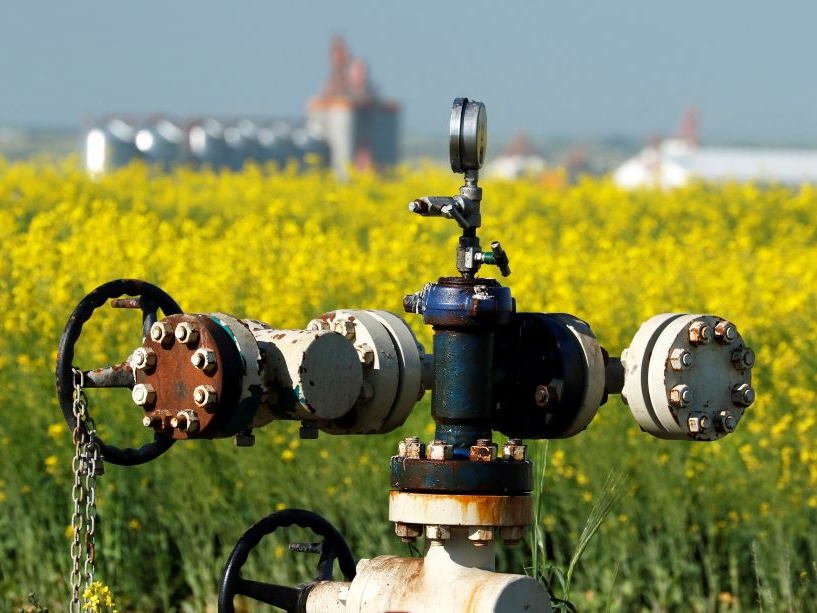Alberta owns a new record. The province is home to an abandoned and unplugged gas well that leaks methane, an explosive greenhouse gas, into the atmosphere at the highest rate ever recorded in North America.
The super-emitter spews approximately nine cubic metres of gas per hour, or 78,840 cubic metres of gas a year. That’s enough to heat an average Canadian residence for nearly 34 years.
The leak is two to three times higher than the previously published record emission rate from an unplugged well in Pennsylvania in 2014.
McGill University researchers made the discovery while undertaking, for the first time, direct measurements of methane emission rates at 238 abandoned and unplugged wells in the oil-dependent provinces of Alberta and Saskatchewan.
Based on these findings, the researchers now estimate that some 400,000 inactive and unplugged wells in Canada probably pollute the atmosphere with 85 to 93 kilotonnes of methane every year. That’s equivalent to the emissions of 1.5 million cars.
Those suspended wells, a major financial liability for the province, represent just the tip of the iceberg when it comes to industry’s methane pollution.
A recent Carleton University study found that the industry released at least 1,922 kilotonnes in B.C., Alberta and Saskatchewan in 2021 and that regulators had underestimated the sheer volume of the problem by 50 per cent.
Scientists admit there is a high degree of uncertainty about the contribution of abandoned and unplugged wells to methane pollution because industry and their regulators assumed for years that they didn’t leak much.
But Mary Kang, a civil engineer at McGill and one of the study’s co-authors, demolished those claims in a previous study in Pennsylvania, where the oil age began in the 1850s.
After directly measuring the rate of methane emissions from abandoned wells, Kang discovered that some were super-emitters. She concluded that thousands of abandoned wells in that state accounted for anywhere from four to seven per cent of methane emissions in Pennsylvania.
Super-emitting wells are a problem in Alberta and Saskatchewan. According to the McGill study, one in 20 unplugged wells were “super high emitters” of methane.
Researchers also found the greatest leakage rates in Grande Prairie, an area of high fracking activity. The area’s abandoned wells leaked at levels 13 times higher than for leaking gas wells around Medicine Hat, an area of historic gas production, and for heavy oil wells in Lloydminster.
The study also noted that up to 82 per cent of the leaks came from an uncontrolled flow of formation gas or fluid through the surface casing vent assembly at the wellhead.
That means subsurface leaks occur at a rate three times higher (32 per cent) than that estimated by the provincial regulator. These underground leaks, which can migrate into homes, causing explosions, also indicate that “well integrity failures and groundwater contamination are likely to be more common than previous studies suggest.”
Kang told The Tyee that it was important “to fix these well integrity issues. Plugging a well doesn’t do that.”
Anthony Ingraffea, a civil and environmental engineer and world authority on fracking at Cornell University, called the findings significant. “Regulators rely on industry to make measurements of leaks and industry relies on protocols that will invariably underestimate actual leakage,” Ingraffea told The Tyee.
“Kang’s study found total annual emissions from all abandoned oil and gas wells in Canada to be 38 per cent higher than the estimate of the Canadian national inventory report,” he said.
Moreover, the study shows just how off base industry estimates can be “when it misses the super-emitters like those they found in both Alberta and Saskatchewan,” he said.
Underestimating a powerful climate change accelerator
Methane plays a large role in accelerating climate change. Its ability to trap heat is 25 times more powerful than that of carbon dioxide. As a consequence it is the only greenhouse gas that, if dramatically reduced, could actually slow the pace of climate change.
But global methane levels reached record levels last year.
Canada’s oil and gas industry is the largest single methane polluter in the country and accounts for 40 per cent of the nation’s emissions.
Every sector of the oil and gas industry, from oilsands to fracking operations, leaks methane into the soil, water or atmosphere. About one-third of the emissions are leaks often from uncertain sources including unplugged wells. The rest include flaring and venting from tanks, compressors and other equipment.
Kang’s study follows on the heels of another major methane inventory completed by Matthew Johnson’s team at the Energy and Emissions Research Lab at Carleton University.
They found methane emissions from Alberta’s oil and gas facilities were on average 50 per cent higher than assumed by Alberta and industry — a finding that prompted a dismissive outburst from Alberta’s environment minister, Rebecca Schulz.
Yet U.S. and Canadian studies have consistently found that the oil and gas industry has grossly underestimated its methane leakage problem.
For example, a 2021 study that measured emissions at 6,650 sites in six major fossil fuel regions in Canada found that industry produced half again as many emissions as it reported.
Another study observed that “regulatory submissions captured only a small amount of the total methane inventory and we also observed a low bias in regulatory reporting.”
Using flyovers with methane monitors and data from satellites, Johnson’s team scanned and quantified methane emissions at 3,500 different oil and gas facilities and 5,600 wells.
Contrary to official provincial estimates, almost two-thirds of emissions came from uncontrolled tanks, pneumatic equipment and unlit flares.
Johnson’s team found that, on average, Alberta’s oilpatch leaks about 1.7 per cent of produced methane into the atmosphere. That’s much higher intensity than most active U.S. oil and gas basins and four times higher than methane leaks in northeastern B.C.
The European Union is considering putting limits on methane imports if they come from basins where the leakage intensity is greater than 0.2 per cent because of the gas’s dramatic impact on climate change. The United States is also considering a methane tax on polluting sources.
However, Alberta’s Schulz said she would take the results of Johnson’s study “with a grain of salt.” She added, “A number of the authors are linked with groups that are fundamentally opposed to our oil and gas industry and want to see it shut down.”
Researchers for the Environmental Defense Fund, an environmental charity that actively collaborates with industry and government, are co-authors on the study.
Johnson called Schulz’s comments “incredibly disappointing” in an email to The Tyee. He added that the Alberta inventory was peer-reviewed in one of the top journals of the field and follows an extensively detailed and transparent methodology. “This includes independent satellite measurements published by a completely separate group of authors and independent aerial mass balance flights (using a separate plane and separate technology) that were organized by our co-authors on the paper from EDF.”
According to an annual J.P. Morgan energy report, nearly a dozen U.S. studies have consistently found official numbers on methane leaks to be totally unreliable. In fact, estimates by industry and regulators routinely fall short of the scale of methane leakage when challenged by direct measurements by plane, ground monitoring, drones or satellites.
Johnson said that even if the Alberta government doesn’t “believe in methane reductions from an environmental perspective, the world is nevertheless incredibly rapidly and strongly aligning on a 0.2 per cent methane intensity threshold for oil and gas.”
Schulz recently celebrated a provincial program that claims to have reduced methane emissions three years ahead of schedule by 45 per cent since 2014.
But Johnson said the scientific evidence questions those claims, calling “any discussion about a 45 per cent reduction ultimately arbitrary and largely irrelevant.”
But Alberta’s United Conservative government, which receives a third of its revenue from oil and gas development, is unlikely to co-operate.
After the federal government announced plans to reduce methane emissions in the oilpatch by 75 per cent by 2035, Premier Danielle Smith, a longtime defender of the industry, vowed to “use every tool at our disposal to ensure these absurd federal regulations are never implemented in our province.” ![]()
Read more: Energy, Politics, Alberta, Environment

















Tyee Commenting Guidelines
Comments that violate guidelines risk being deleted, and violations may result in a temporary or permanent user ban. Maintain the spirit of good conversation to stay in the discussion and be patient with moderators. Comments are reviewed regularly but not in real time.
Do:
Do not: